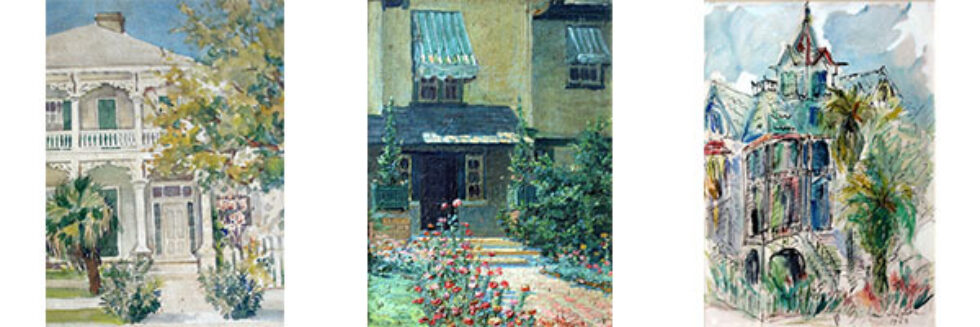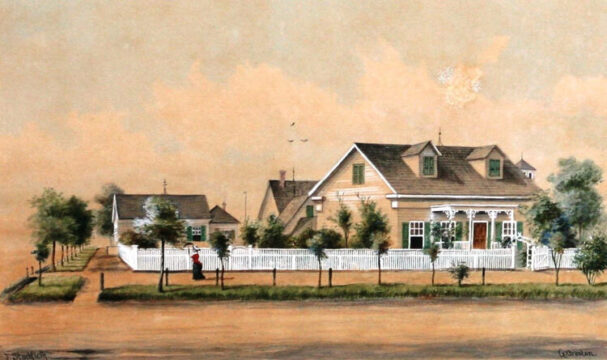
Rosenberg Library’s art exhibit Island Art / Island Architecture: Paintings of Historic Galveston Homes, featured a large number of works from the library’s permanent collection as well as works loaned by local residents.
While many of the historic homes in the exhibit are still standing — such as Open Gates, which is featured on the 2013 Homes Tour — others were lost over the years to storms, fires, or demolition in the name of progress. Island Art / Island Architectureis a celebration of Galveston’s history, architecture, and artistic heritage. From simple cottages to magnificent mansions, these paintings capture some of the island’s most charming domestic dwellings.
This exhibit represents Rosenberg Library’s strong commitment to the preservation of Galveston’s artistic treasures. During the past year and a half, many paintings have been professionally conserved in preparation for the show. Additional works were reframed using archival-quality materials to ensure their long-term preservation. More than $20,000 has been invested in this critical project.
Some of these paintings and frames are nearly 130 years old and were in dire need of cleaning and repair. Others were in good condition but were framed with acidic materials which had caused discoloration. Viewers of the exhibit had a chance to see before-and-after images of many of the paintings which underwent extensive conservation treatment.
Island Art / Island Architecture featured artists:
Julius Stockfleth
Six paintings in the show were done by one of Galveston’s most famous artists, Julius Stockfleth (1857 – 1935). Stockfleth was born in Germany during the middle of the 19th century. His father was a ship joiner and sailor, and his mother was an innkeeper. In 1883, Stockfleth immigrated to the United States; he settled in Galveston two years later and began his career as a professional painter on the island. He returned to Germany in 1907, where he continued his art career until his death in the 1930s. During his twenty years in Texas, Stockfleth produced an invaluable artistic record of historic Galveston.
While best known for his ship portraits, Stockfleth also painted a number of Galveston residences. Included in the show are three different views of the antebellum William Jefferson Jones Home.
A native of Virginia, Judge William Jefferson Jones came to Galveston in 1852. In 1855, he erected a plantation house at Virginia Point, an area located at the very tip of the mainland. Jones was the first person to successfully harvest sea-island cotton in Texas and make use of its oil. After the Civil War he sold farm tracks to former slaves in an area that would become known as Highland Station.

Other Stockfleth works in the exhibit include the Henry Greenrood Home at 1224 Avenue G, the original Lucas Row apartment complex, which was destroyed during the 1900 Storm, and the Nicolini House at Tremont and P ½ during the post-storm grade raising.
Grace Spaulding John

A well-known artist in Houston and Galveston, Grace Spaulding John (1890 – 1972) studied at the Chicago Art Institute, the Art Students League in New York City, and the Pennsylvania Academy of Fine Art. Upon returning to Texas, she married Alfred Morgan John, a prominent attorney and the great-grandson of Sam Houston. John was one of the first artists — male or female — to have a solo showing at the Museum of Fine Arts. Examples of her work can be found in numerous national collections including that of the Smithsonian Institution and the Museum of the City New York.
John was commissioned to paint a number of elite residences in Galveston, including that of the Copley family. Located at the corner of Broadway and 25th, this house was built in 1915 for George Noble Copley and his wife Eveline Goggan Copley. Copley served as secretary-treasurer during the post-1900 Storm grade raising. The Copleys sold the home to the Phillips family who owned it until 1955. Its next owner, Mary E. McCowan, sold the home to American Oil Company which demolished the house in 1956 to build a service station on the lot. A second work by John in the show features one of Galveston’s most famous architectural landmarks, “Open Gates,” home of the Sealy family. Galveston businessman George Sealy made a fortune as one of the founders of the Gulf, Colorado, and Santa Fe Railway. In the late 1880s, his wife, Magnolia Willis Sealy, commissioned one of America’s foremost architectural firms —McKim, Mead, and White — to design a home for their large family. The multi-colored stone and terra-cotta mansion with surrounding gardens set a new standard for Galveston’s elite houses. Galveston architect Nicholas Clayton designed the adjacent carriage house in 1891.

Joan Singleton
Works by another Galveston female artist, Joan Singleton (1915 – 1982), were also featured in the exhibit. Born in Ontario, Canada, Singleton came to Galveston with her husband, Dr. Albert O. Singleton Jr., a surgeon at University of Texas Medical Branch. Singleton’s works stand out as some of the most colorful and whimsical in the exhibit.
One example is a painting of the Sawyer-Flood House which was built around 1879 at Broadway and 16th Street. Sea captain Jeremiah N. Sawyer, the original owner, sold the home to E.O. Flood in 1905. A native New Yorker, Flood came to Galveston in the 1870s and established a coal shipping firm. The Flood family retained ownership of the property until 1948. It was demolished in 1965.
Eugene Aubry
In 2009, BOI and prominent Houston architect Eugene Aubry (b. 1935) created a number of paintings of historic Galveston homes for the 2012 publication Born on the Island: The Galveston We Remember. Two of the watercolors featured in the book were part of the Library exhibit including the image 503 17th which appears on the cover.
Architect C.W. Bulger designed this house for concrete contractor Isaac Heffron in 1900. The house was oriented toward 17th Street rather than Postoffice in order to take full advantage of the Gulf breeze. Likewise, the second-story bays allowed for maximum ventilation.
